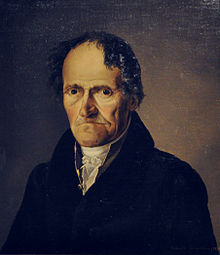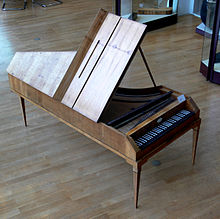Gabriel Anton Walter (* 5. Februar 1752 in Neuhausen auf den Fildern; † 11. April 1826 in Wien) war einer der bedeutendsten Klavierbauer zur Zeit der Wiener Klassik.

Walter was born in Neuhausen auf den Fildern, Germany.[1] The record of his marriage to a widow named Anna Elisabeth Schöffstoss in 1780 indicates that he had moved to Vienna by that time.[2] His earlier surviving pianos are dated to this year.
Walter's pianos:
Walter's instruments are classified within the so-called "Viennese" school of piano design. This school originated with Johann Andreas Stein, who built pianos in Augsburg.[1] In Viennese instruments, the head of the hammer is closer to the player than the hinge, and the hammer is made to rise when its short opposite end is caught on a hook. Like all early pianos, those of the Viennese school were of far lighter construction than modern instruments and had a quite distinct sound; for general discussion, see fortepiano.
Walter improved on Stein's design by adding to the action a back check, which caught the hammer on its descent, preventing it from bouncing up and down in lively playing.[1] This innovation was generally adopted by other Viennese makers in Walter's time, and remains standard in the modern piano.[1] Its importance is illustrated by an observation of Palmieri and Palmieri, namely that modern replicas of Stein pianos commonly include a back check even though it is not historically authentic on these instruments.[3]
Walter's career extended over several decades, and his instruments evolved with the times, with ever heavier construction as the piano began its shift from the lightweight Classical-era norm toward its far heavier modern incarnation, achieved by about 1870. It appears that Walter eventually fell behind his competitors (notably Conrad Graf, who built much heavier instruments) and was less successful in the competition among makers during the last years of his career.[citation needed]. He died in Vienna, aged 74.
Hammerflügel der Fa. Anton Walter & Sohn, Wien um 1810

Mozart's instrument:
Wolfgang Amadeus Mozart bought a Walter piano in about 1782,[1] and employed it in one of the most important phases of his career, the composition and highly successful premieres of his mature piano concertos (see: Mozart piano concertos). In 1800 (nine years after Mozart's death), this instrument was modified by Walter.[1] It survives today (and is kept in Mozart's birth home in Salzburg), but cannot provide reliable testimony for Mozart's own performance practice, due to Walter's modifications. Most pertinently, we cannot know whether Mozart was able to raise the dampers during playing using a knee lever (the equivalent of the modern damper pedal) or had to make use of a hand stop at keyboard level, which would have necessitated a free hand. A Walter instrument in Nuremberg, dated 1790 by Kottick and Lucktenberg, uses hand stops.
Surviving Walter pianos:
The following list is not complete and emphasizes instruments on public view.
(1780) Burgenländische Landesmuseum, Eisenstadt, Austria[6]
(early 1780s) The Mozart instrument, now kept in the composer's birth home in Salzburg[7]
(1790) Rector's Palace in Dubrovnik
(ca. 1790) Germanisches Nationalmuseum, Nuremberg (mentioned above in discussion of hand stops). The instrument is veneered in walnut. The museum owns other Walters, including one quite similar to Mozart's.[4]
(ca. 1800) Musikinstrumenten-Museum, Berlin[8]
(1798) Villa Cicogna Mozzoni Italy.
(ca. 1800) Finchcocks collection, Goudhurst, England. A very small portable square piano by Walter & Sohn. Each note has but one string, in contrast to the usual two or three used in most pianos even in Walter's day. The range is C–f3. Kottick and Lucktenberg describe its tone as having a "bell-like quality that never fails to charm."[9]
(ca. 1810) Württembergisches Landesmuseum, Stuttgart. This instrument has a 6½ half octave range, an octave and a half more than the standard (F–f) of Mozart's day. It is decorated (Kottick and Lucktenberg) with "gilded caryatids and grillework and medallions in brass."[10]
(1820) Bach-Haus, Eisenach. A square piano made by Johann Schieve and Walter & Sohn.[11]
(1820–1825) Kunsthistorisches Museum, Vienna. A painting by Wilhem Rieder appears to show Franz Schubert playing on this instrument.[8]
(1820–1830) National Museum, Prague. A six-pedal piano described by Kottick and Lucktenberg as "eye-catching ... an elegant and harmonious example of the finest piano making of the time."[12]
(no date given) Musée de la Musique, Paris[13]
|
